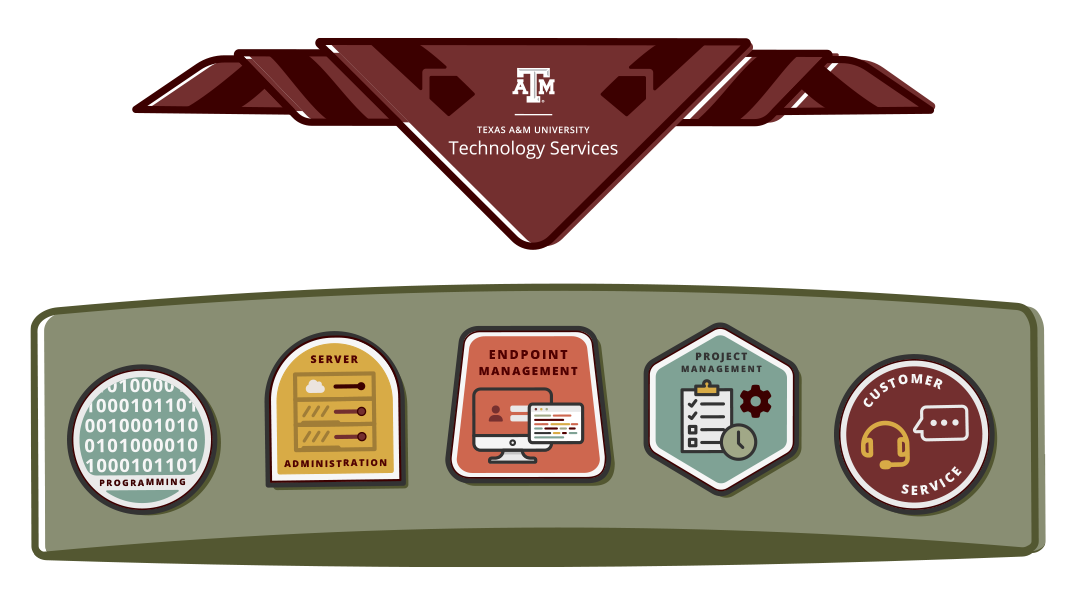Careers
Investing in people

In an effort to recruit, retain and develop top IT talent, Technology Services has pursued a rigorous initiative to expand career opportunities for staff and create entry-level opportunities for students by addressing three clearly defined objectives:
- Create professional titles that better reflect the evolving IT landscape and what is found across industry.
- Establish defined career paths for all employees.
- Establish entry-level positions for student workers to be hired upon graduation.
Developing successful employees is a top priority, with strategies being developed and implemented to retain current talent. Technology Services has prioritized the evaluation of all current IT titles, job duties and compensation to help compete with industry opportunities and align with the university’s strategy for career progression, both within technical and managerial ladders.
With technology careers growing more competitive each year, Technology Services also designed the student IT experience program to give undergraduates interested in IT a head start to begin their career. Students gain hands-on learning tied to career goals, including training opportunities and the ability to earn industry certifications, all with the ultimate goal of retaining qualified student workers in the organization.
Maximizing Value
Skills inventory to develop and align team

Technology Services developed an inventory to identify the IT skill sets of employees across campus. The inventory will be used to develop and align personnel within the Technology Services team. To date, based on the responses from 574 IT professionals surveyed, the skills inventory demonstrated the top 5 skills held represent programming, server administration, endpoint management, project management and customer service. In addition, the survey provided insight on areas where growth opportunities exist through demand management, systems development management, learning delivery, quality management and portfolio management.
This inventory allows Technology Services to identify the various strengths, skills, competencies and opportunities at an organizational level. In addition, this inventory allows for a focused understanding of each employee’s aspirations for career development, whether it be technical or managerial.
The most requested training categories include macOS and iOS support (JAMF and Apple Hardware Support), leadership (supervision, governance, organizational leadership and diversity), project management (PMP, Agile and Scrum), programming (Python, JavaScript, PowerShell, .NET, C++, C# and Swift) and IT frameworks (ITIL, Six Sigma and Lean).
Providing professional development opportunities
Technology Services’ professional development enhancement program provides career growth opportunities for all IT employees. This program is especially important with the recent unification of IT professionals across campus. Each employee is required to take four courses: one on project management, one on emotional intelligence and two additional elective trainings fulfilled through official Technology Services’ Speaker Bureau or Technically Speaking events, outside training and LinkedIn Learning courses, or the Technology Services book study group. This program is intended to encourage career growth opportunities for technology professionals and equip them with the knowledge and skills needed to address technology challenges.
Partner Success
Career paths for students

As technology careers grow more competitive each year, Technology Services designed the student IT experience program to offer undergraduates interested in information technology a head start in their career. The program provides opportunities to gain hands-on learning tied to long-term career goals, including training opportunities and earning industry certifications. There is a concerted effort to recruit and retain student workers through job fairs, social media campaigns and targeted email, creating a pipeline of graduates prepared to fill entry-level positions.
In collaboration with the Division of Human Resources and Organizational Effectiveness, the job descriptions of entry level roles have been evaluated, ensuring minimum requirements align with the skills needed. In addition to student worker career paths, this internal partnership has led to modernization of employment titles in an effort to create more transparent, defined career ladders for current employees, both in managerial and technical positions.
ITAC works with HROE to restructure career ladders
In early 2022, the Information Technology Advisory Committee (ITAC) began a detailed and thorough examination of current Texas A&M IT titles, job duties and compensation in comparison to the broader IT industry. Ed Pierson, CIO and Vice President for Technology Services, tasked ITAC to establish entry-level positions, expanding jobs to recent graduates, those without a degree and and applicants without IT experience. In addition, the committee was charged with creating titles that reflect the evolving IT landscape, and are comparable with those found in industry, and define career paths for all employees within Technology Services. ITAC established six sub-committees made up of IT professionals from across campus to focus on the following areas:
- Application/Web Development
- System Administration/Cloud
- Project Management/BRM/Management/Leadership
- Help Desk/Desktop Support/Classroom/AV Support
- Security/Compliance/Policy
- Networking/Telecommunications
These committees researched how IT professionals grow within their careers, including an in-depth study of current IT career ladders, working titles, career advancement and compensation. The proposed career ladders will address each of these areas, and provide separate technical and managerial paths.
ITAC and Technology Services leadership continue to work closely with the Division of Human Resources and Organization Effectiveness (HROE) to ensure all titles, career paths and position descriptions align with the strategy for career progression. Creating a clear path for all Texas A&M employees is a key focus for campus leadership.
Technology Services will unveil the new HROE titles, associated working titles and IT career paths in a phased approach to successfully implement these opportunities within the organization. Additionally wIth the unification of IT, total personnel increased to more than 720 staff members. Technology Services is partnering with HROE to hire an internal recruiter to help ensure IT is supported in identifying and recruiting qualified applicants while also ensuring each position relates to an IT career path for professional growth.
Additionally, a mid-year review process was implemented to identity and track employee career goals and aspirations. These mid-year reviews will lay the foundation for career growth and professional development for each Technology Services employee.